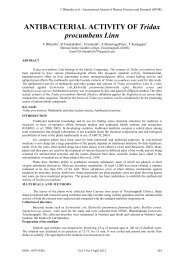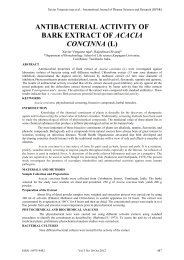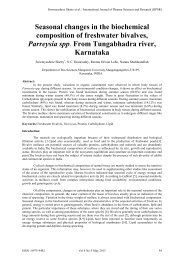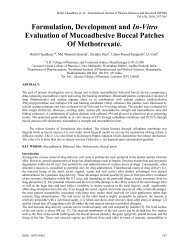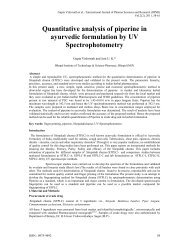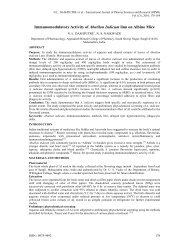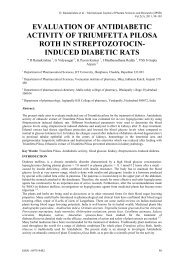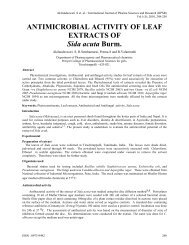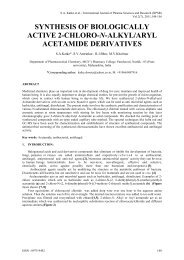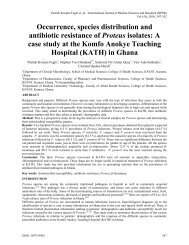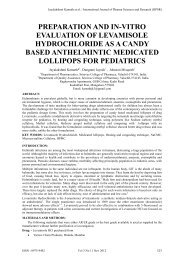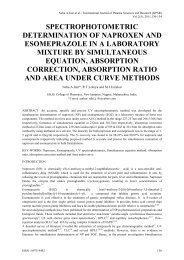Hepatoprotective Activity of Melia azedarach.L Against ...
Hepatoprotective Activity of Melia azedarach.L Against ...
Hepatoprotective Activity of Melia azedarach.L Against ...
You also want an ePaper? Increase the reach of your titles
YUMPU automatically turns print PDFs into web optimized ePapers that Google loves.
Dr.A.Sumathi / International Journal <strong>of</strong> Pharma Sciences and Research (IJPSR)<br />
<strong>Hepatoprotective</strong> <strong>Activity</strong> <strong>of</strong> <strong>Melia</strong><br />
<strong>azedarach</strong>.L <strong>Against</strong> Carbontetrachloride-<br />
Induced Hepatic Damage In Rats<br />
Abstract<br />
Dr.A.Sumathi<br />
Assistant Pr<strong>of</strong>essor,<br />
Department <strong>of</strong> Biotechnology,<br />
Hindusthan College <strong>of</strong> Arts and Science,<br />
Coimbatore-641028, Tamilnadu, India<br />
The leaves <strong>of</strong> <strong>Melia</strong> <strong>azedarach</strong>.L, family <strong>Melia</strong>ceae was tested for hepatoprotective activity<br />
against CCl 4 in rats. The ethanol extract <strong>of</strong> <strong>Melia</strong> <strong>azedarach</strong>.L has shown significant activity, lowering the serum<br />
enzymes like SGOT and SGPT in rats intoxicated with CCl 4 .<br />
Keywords: <strong>Melia</strong> <strong>azedarach</strong>.L, hepatoprotective, carbon tetrachloride<br />
Introduction<br />
<strong>Melia</strong> <strong>azedarach</strong>.L, family <strong>Melia</strong>ceae is from west Asia. It is widly distributed in Himalayan region between the<br />
attitude <strong>of</strong> 700 to 1000m. A moderate-sized deciduous tree 9-12m in height with a cylindrical bole with dark grey<br />
bark having shallow longitudinal furrows; The leaves are bi- or tripinnate, pinnate opposite or alternate, ovate or<br />
lanceolate, serrate, acuminate, glabrous on both surface, slightly oblique at the base. 1 It has been used for various<br />
medicinal purposes. 2 The leaf juice is used as an anthelmintic. It is also used to cure strangury, amenorrhoea,<br />
bronchitis, leprosy, eczema, asthma and as an antipyretic. 3 Phytochemical studies reveal the presence <strong>of</strong><br />
alkaloids, flavanoids, steroids, tannins and lycopena etc., 4 The present study was made to evaluate the effect <strong>of</strong><br />
ethanol extract <strong>of</strong> <strong>Melia</strong> <strong>azedarach</strong>.L against CCl 4 -induced hepatic damage in rats.<br />
<strong>Melia</strong> <strong>azedarach</strong>.L against CCl 4 -induced hepatic damage in rats.<br />
Materials and methods<br />
The leaves <strong>of</strong> <strong>Melia</strong> <strong>azedarach</strong>. L were collected from the Western Ghats <strong>of</strong> Anamalai Hills, Coimbatore district,<br />
Tamilnadu. The plant was identified and authenticated by Botanical Survey <strong>of</strong> India (IBSI), Coimbatore,<br />
Tamilnadu, India. The leaves <strong>of</strong> the plant were collected and dried. The dried and powdered aerial parts <strong>of</strong> the<br />
plant (250gm) were extracted with ethyl acetate using soxhlet apparatus and concentrated in-vacuo.<br />
Approximately, 0.50g <strong>of</strong> dried ethanol extract was obtained from 30g <strong>of</strong> dried stem material. The extract was<br />
suspended in 50% gum acacia and used for studying hepatoprotective activity.<br />
Male albino rats weighing between 160 and 200 g were used as animal models. The rats were divided into four<br />
groups, each group consisting <strong>of</strong> six animals. <strong>Hepatoprotective</strong> activity <strong>of</strong> <strong>Melia</strong> <strong>azedarach</strong>.L, was evaluated<br />
using CCl 4 -induced model. 5 Group one was kept on normal diet and served as control, the second group received<br />
CCl 4 (1.25 ml/kg) by oral route, the third and fourth group received silymarin (100 mg/kg; po) and extract <strong>of</strong><br />
<strong>Melia</strong> <strong>azedarach</strong>. L (300 mg/kg; po) respectively once daily, for seven days. On the seventh day, CCl 4 was given<br />
by oral route 30 min after the administration <strong>of</strong> silymarin and test drug. After 36h <strong>of</strong> CCl 4 administration, blood<br />
was collected and serum separated was analyzed for various biochemical parameters.<br />
Biochemical parameters like serum glutamic oxaloacetic transaminase (SGOT) and serum glutamic pyruvate<br />
transaminase (SGPT) were determined by Reitman and Frankel method. 6 Serum alkaline phosphatase was<br />
determined by King and Kings method. 7 Malby and Evelyn method 8 was followed to estimate total bilirubin<br />
content.<br />
ISSN : 0975-9492 Vol 3 No 5 May 2012 387
Dr.A.Sumathi / International Journal <strong>of</strong> Pharma Sciences and Research (IJPSR)<br />
The liver was examined grossly, weighed and stored in formalin 10% and were processed in embedded paraffin<br />
using the standard microtecnique. 9 A section <strong>of</strong> the liver (5μm) stained with alumhemotoxylin and eosin was<br />
observed microscopically for histological studies.<br />
Results and discussion<br />
The results <strong>of</strong> biochemical parameters has shown the elevation <strong>of</strong> enzyme level in CCl4-treated group, indicating<br />
that CCl 4 induces damage to the liver (Table 1). Liver tissue rich in both transaminase increased in patients with<br />
acule hepatic diseases, SGPT which is slightly elevated by cardiac necrosis is a more specific indicator <strong>of</strong> liver<br />
disease. 10 A significant reduction (P < 0.01) was observed in SGPT, SGOT, ALP and total bilirubin levels in the<br />
groups treated with silymarin and ethanol extract <strong>of</strong> <strong>Melia</strong> <strong>azedarach</strong>. L. The enzyme levels were almost restored<br />
to the normal.<br />
It is observed that the size <strong>of</strong> the liver was enlarged in CCl 4 -intoxicated rats but it was found to be normal in<br />
drug– treated groups. A significant reduction (P < 0.001) in liver weight supports this finding.<br />
It was found that the extract decreased the CCl 4 -induced elevated levels <strong>of</strong> the enzymes in group third and fourth,<br />
indicating the production <strong>of</strong> structural integrity <strong>of</strong> hepatocytic cell membrane or regeneration <strong>of</strong> damaged liver<br />
cells by the extract.<br />
Histopathological examination <strong>of</strong> the liver section <strong>of</strong> the rats treated with toxicant showed intense centrilobular<br />
necrosis and vaculization. The rats treated with silymarin and extracts along with toxicants showed sign to<br />
considerable extent as evident from formation <strong>of</strong> normal hepatic cards and absence <strong>of</strong> necrosis and vacuoles.<br />
Decrease in serum bilirubin after treatment with the extract in liver damage indicated the effectiveness <strong>of</strong> the<br />
extant in liver damage indicated the effectiveness <strong>of</strong> the extract in normal functional status <strong>of</strong> the liver. The<br />
phytochemical studies revealed the presence <strong>of</strong> flavonoids in ethanol extract <strong>of</strong> <strong>Melia</strong> <strong>azedarach</strong>. L various<br />
flavonoids have been reported for their hepatoprotective activity. 11 The hepatoprotective effect <strong>of</strong> <strong>Melia</strong><br />
<strong>azedarach</strong>. L may be due to its flavonoid content.<br />
Table 1. Effect <strong>of</strong> ethyl acetate extract <strong>of</strong> <strong>Melia</strong> <strong>azedarach</strong>. L on CCl4 treated rats Design <strong>of</strong> treatment Liver (wt/100g)<br />
Design <strong>of</strong> Liver(wt/100g Dose(mg/kg) SGPT SGOT ALP Total Bil<br />
treatment body wt U/L U/L U/L<br />
Control 3.9±0.02 ----- 131.7±2.03 44.8±0.77 166.4±3.11 0.79±0.02<br />
CCL4 6.2±0.29 1.25ml/kg 222.6±4.6 347.3±2.6 387.9±16.13 2.16±0.01<br />
Silymarin+CCl4 3.7±0.21 100 132.2±1.12 83.7±9.14 212.8±5.21 0.8±0.07<br />
Ethanol 4.6±0.17 300 117.4±1.09 68.5±5.21 287.9±4.96 0.84±0.01<br />
extract+CCL4<br />
N = 6 animals in each group.<br />
*P < 0.001; **P < 0.01 when compared<br />
with control. Values are expressed as<br />
mean + SE.<br />
References<br />
[1] P. K.. Warrier, V. P. K. Nambiar and C. Ramankutty. Indian Medicinal plants: a compendium <strong>of</strong> 500 species, Orient Longman Ltd.,<br />
Madras, 1933, 4 : 10.<br />
[2] F.I. Bohnenstengel, V. L. Wray, R.P. Srivastava and P. Proksch. Secolimonoids from <strong>Melia</strong> azadirach. Phytochemistry, 1999, 50,977-<br />
982.<br />
[3] P. B. Oelrichs, M. W. Hill, P.J. Vallely, J.K. Macleod and T.F. Molinski. The chemistry and pathology <strong>of</strong> <strong>Melia</strong> toxins A and B<br />
constituents from the fruit <strong>of</strong> <strong>Melia</strong> <strong>azedarach</strong> L. var. australasica, In : A.A. Seawright, M.P. Hegarty, L.F. James, et al. (ed.) Plant<br />
Taxicology. Queensland Poisonous Plants Committee,Yeerongpilly, Australia. 1985, 387-394.<br />
[4] H.Gerster. Potancial role <strong>of</strong> β-carotene in the prevension <strong>of</strong> cardiovascular disease. International J. Vit. Nutr. Res., 1997, 61, 277-291.<br />
[5] B.M. Vrushabendra Swamy, G.S. Kumar, S.I.. Shiva Kumar, H.M. Suresh, V.Rajasheker and C.Sreedhar. Evaluation <strong>of</strong><br />
hepatoprotective effects <strong>of</strong> Coccinia grandis Linn. <strong>Against</strong> CCl 4 induced liver damage in Wistar rats. 2007.<br />
[6] S. Reitman and S.Frankel, Invitro determination <strong>of</strong> transaminase activity in serum, Am. J. Clin. Path., 1975, 28, 56-58.<br />
[7] P.N. Kind and E.J.King, Invitro determination <strong>of</strong> serum alkaline phosphatase. J. Clin. Path., 1971, 7, 322-336.<br />
[8] H.T. Mallary and K.A .Evelyn. Estimation <strong>of</strong> serum bilirubin level. J.Biol. Chem., 1937, 119,481-484.<br />
[9] A.E. Galigher and E.N .Kozl<strong>of</strong>f. Essential Practical Micretechnique, Lea and Febiger, Philadelphia, 1971, 2nd edn,77 .<br />
[10] V.W. Rodwell, D.W.Martin, P.A. Mayg and D.K. Garnner. Harper Review <strong>of</strong> Biochemistry, Lange Medical Publisher, California,<br />
1983, 20th edn, 62.<br />
[11] K.J. Raj and K. Shalini. Flavonoids – A Review <strong>of</strong> Biological activities. Indian Drugs, 1999, 36, 668-673.<br />
ISSN : 0975-9492 Vol 3 No 5 May 2012 388



